 полная версия
полная версияStories of Useful Inventions
If we could step on board a Malay proa we should see floating in a bucket of water a cocoanut shell having a small perforation through which the water by slow degrees finds its way into the interior. This orifice is so perforated that the shell will fill and sink in an hour, when the man on watch calls the time and sets it to float again. This sinking cocoanut shell, the first form of the water-clock, is the clock from which has been developed the timepiece of to-day. With it, therefore, the story of the clock really begins. In Northern India the cocoanut shell is replaced by a copper bowl (Fig. 3). At the moment the sinking occurs the attendant announces the hour by striking upon the bowl.
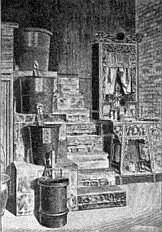
FIG. 4. – CHINESE WATER-CLOCK AT CANTON.
The second step in the development of the water-clock was made in China several thousand years ago. In the earlier Chinese clock the water, instead of finding its way into the vessel from the outside, was placed inside and allowed to trickle out through a hole in the bottom and fall into a vessel below. In the lower vessel was a float which rose with the water. To the float was attached an indicator which pointed out the hours as the water rose. By this arrangement, when the upper vessel was full, the water, by reason of greater pressure, ran out faster at first than at any other time. The indicator, therefore, at first rose faster than it ought, and after a while did not rise as fast as it ought to. After centuries of experience with the two-vessel arrangement, a third vessel was brought upon the scene. This was placed above the upper vessel, which now became the middle vessel. As fast as water flowed from the middle vessel it was replaced by a stream flowing from the one above it. The depth of the water in the middle vessel did not change, and the water flowed into the lowest vessel at a uniform rate. Finally a fourth vessel was brought into use. The Chinese water-clock shown in (Fig. 4) has been running in the city of Canton for nearly six hundred years. Every afternoon at five, since 1321, the lowest jar has been emptied into the uppermost one and the clock thus wound up for another day.

FIG. 5. – AN EARLY GREEK CLEPSYDRA.
To follow the further development of the water-clock we must pass from China to Greece. In their early history the Greeks had nothing better than the sun-dial with which to measure time. About the middle of the fifth century B. C. there arose at Athens a need for a better timepiece. In the public assembly the orators were consuming too much time, and in the courts of law the speeches of the lawyers were too long. It was a common thing for a lawyer to harangue his audience for seven or eight hours. To save the city from being talked to death a time-check of some kind became necessary. The sun-dial would not answer, for the sun did not always shine, even in sunny Greece; so the idea of the water-clock was borrowed. A certain amount of water was placed in an amphora (urn), in the bottom of which was a small hole through which the water might slowly flow (Fig. 5). When the amphora was empty the speaker had to stop talking. The Greeks called the water-clock a clepsydra, which means "the water steals away." The orator whose time was limited by a certain amount of water would keep his eye on the clepsydra, just as a speaker in our time keeps his eye on the clock, and if he were interrupted he would shout to the attendant, "You there, stop the water," or would say to the one who interrupted him, "Remember, sir, you are in my water." The story goes that upon one occasion the speaker stopped every now and then to take a drink; the orator's speech, it seems, was as dry as his throat, and a bystander cried out: "Drink out of the clepsydra, and then you will give pleasure both to yourself and to your audience."
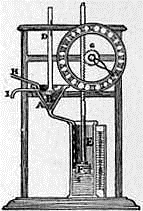
FIG. 6. – AN IMPROVED GREEK CLEPSYDRA.
At first the Greeks used a simple form of the clepsydra, but they gradually adopted the improvements made by the Chinese, and finally added others. The great Plato is said to have turned his attention to commonplace things long enough to invent a clepsydra that would announce the hour by playing the flute. However this may have been, there was in use in the Greek world, about 300 B. C., a clepsydra something like the one shown in Fig. 6. This begins to look something like a clock. As the water drops into the cylinder E the float F rises and turns G, which carries the hour hand around. Inside of the funnel A is a cone B which can be raised or lowered by the bar D. In this way the dropping of the water is regulated. Water runs to the funnel through H, and when the funnel is full the superfluous water runs off through the pipe I, and thus the depth of the water in the funnel remains the same and the pressure does not change. Notice that when the hand in this old clock has indicated twelve hours it begins to count over again, just as it does on our clocks to-day. How easily it would have been to have continued the numbers on to twenty-four, as they do in Italy, and on the railroads in parts of Canada, to-day.
If we pass from Greece to Rome, our usual route when we are tracing a feature of our civilization, we find that the Romans were slow to introduce new methods of timekeeping. The first public sun-dial in Rome was constructed about 200 B. C., an event which the poet Plautus bewailed:
Confound the man who first found outHow to distinguish hours! Confound them, tooWho in this place set up a sun-dialTo cut and hack my days so wretchedlyInto small portions! When I was a boyMy stomach was my sun-dial, one more sure,Truer, and more exact than any of them,This dial told me when 'twas the proper timeTo go to dinner.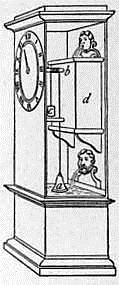
FIG. 7. – A MEDIEVAL CLEPSYDRA.
The water-clock was brought into Rome a little later than the sun-dial, and was used as a time-check upon speakers in the law courts, just as it had been in Athens. When the Romans first began to use the clepsydra it was already a very good clock. Whether it received any great improvements at their hands is not certain. Improvements must have been made somewhere, for early in the Middle Ages we find clepsydras in forms more highly developed than they were in ancient times. In the ninth century the Emperor Charlemagne received as gift from the King of Persia a most interesting timepiece which was worked by water. "The dial was composed of twelve small doors which represented the divisions of the hours; each door opened at the hour it was intended to represent, and out of it came the same number of little balls, which fell, one by one at equal distances of time, on a brass drum. It might be told by the eye what hour it was by the number of doors that were open; and by the ear by the number of balls that fell. When it was twelve o'clock, twelve horsemen in miniature issued forth at the same time, and, marching round the dial, shut all the doors." Less wonderful than the clock of the emperor, but more useful as an object of study, is the medieval clepsydra shown in Figure 7. This looks more than ever like the clock we are accustomed to see. It has weights as well as wheels. As the float A rises with the water it allows the weight C to descend and turns the spindle B on the end of which is the hand which marks the hours. Notice carefully that this is partly a water-clock and partly a weight-clock. The weight in its descent turns the spindle; the water regulates the rate at which the weight may descend.
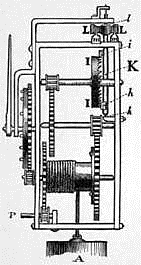
FIG. 8. – DE VICK'S CLOCK. THE FIRST WEIGHT CLOCK. (1370.)
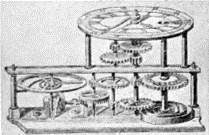
FIG. 9. – A CLOCK WITHOUT WEIGHTS.
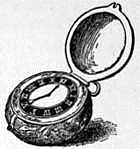
FIG. 10. – A WATCH OF THE 16TH CENTURY.
The water-clock just described led easily and directly to the weight-clock. Clockmakers in the Middle Ages for centuries tried with more or less success to make clocks that would run by means of weights. In 1370, Henry De Vick, a German, succeeded in solving the problem. De Vick was brought to Paris to make a clock for the tower of the king's palace, and he made one that has become famous. In a somewhat improved form it can still be seen in Paris in the Palais de Justice. Let us remove the face of this celebrated timepiece and take a look at its works (Fig. 8). It had a striking part, and a timekeeping part, each distinct from the other. The figure shows only the timekeeping part. The weight (A), of 500 pounds, is wound up by a crank (the key) at P. O is the hour-hand. If A is allowed to descend, you can easily see how the whole system of wheels will be moved – and that very rapidly. But if something does not prevent, A will descend faster and faster, the hour-hand will run faster and faster and the clock will run down at once. If the clock is to run at a uniform rate and for any length of time, the power of the weight must escape gradually. In the clepsydra (Fig. 1) the descent of the weight was controlled by the size of the stream of flowing water. De Vick invented a substitute for the stream of flowing water. Fasten your attention upon the workings of the saw-toothed wheel II and the upright post K, which moves on the pivots l and k, and you may learn what he did. Fixed to the upper part of the post K is a beam or balance LL, at the ends of which are two small weights m and m, and projecting from the post in different directions are two pallets or lips i and h. Now, as the top of the wheel II turns toward you, one of its teeth catches the pallet i and turns the post K a part of the way round toward you. Just as the tooth escapes from i a tooth at the bottom of II (moving from you) catches the pallet h and checks the revolving post and turns it from you. Thus as II turns, it gives a to-and-fro motion to the post K and, consequently, a to-and-fro motion to the balance LL. II is called the escapement because the power of the descending weight gradually escapes from its teeth. In the clepsydra the trickling of water regulated the descent of the weight; in De Vick's clock the trickling of power or force from the escapement regulated the descent of the weight. The invention of this escapement is the greatest event in the history of the clock. The king was much pleased with De Vick's invention. He gave the clockmaker three shillings a day, and allowed him to sleep in the clock tower; a scanty reward indeed for one who had done so much for the world, for De Vick's invention led rapidly to the excellent timepieces of to-day, to both our watches and our clocks. After the appearance of the weight-clock, the water-clock gradually fell into disuse, and all the ingenuity of the clockmaker was bestowed upon weights and wheels and escapements and balances. A century of experimenting resulted in a clock without a weight (Fig. 9). In this timekeeper you recognize the beginnings of the modern watch. The uncoiling of a spring drove the machinery. Instead of the balancing beam with its weights as in De Vick's clock, a balance wheel is used. The escapement is the same as in the first weight-clock. The busy and delicately-hung little balance wheel in your watch is a growth from De Vick's clumsy balance beam. The spring-clock would run in any position. Because it could be carried about it led almost at once to the watch. Many places claim the distinction of having made the first watch, but it seems that the honor belongs to the city of Nürenburg. "Nürenburg eggs," as the first portable clocks were called, were made as early as 1470. The first watches were large, uncouth affairs, resembling small table clocks but by the end of the sixteenth century small watches with works of brass and cases of gold or silver were manufactured (Fig. 10).
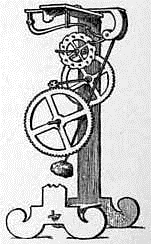
FIG. 11. – GALILEO'S PENDULUM. (1650.)
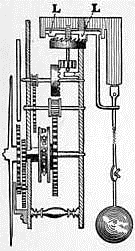
FIG. 12. – THE FIRST PENDULUM CLOCK. (1656.)
The last important step in the development of the clock was taken when the pendulum was brought into use. The history of the pendulum will always include a story told by Galileo. This great astronomer, the story runs, while worshiping in the cathedral at Pisa one day, found the service dull, and began to observe the swinging of the lamps which were suspended from the ceiling. Using his pulse as a timekeeper he learned that where the chains were of the same length the lamp swayed to and fro in equal length of time, whether they traveled through a short space or a long space. This observation set the philosopher to experimenting with pendulums of different lengths. Among the many things he learned one of the most important was this: a pendulum thirty-nine inches in length will make one vibration in just one second of time. Now, if the pendulum could only be kept swinging and its vibrations counted it would serve as a clock. Galileo, of course, saw this, and he caused to be made a machine for keeping the pendulum in motion (Fig. 11), but he did not make a clock; he did not connect his pendulum with the works of a clock. This, however, was done about the middle of the seventeenth century, although it is somewhat difficult to tell who was the first to do it. The honor is claimed by an Englishman, a Frenchman, and a Dutchman. The truth is, clockmakers throughout Europe were trying at the same time to make the best of the discoveries of Galileo, and several of them about the same time constructed clocks with pendulums. The one who seems to have succeeded first was Christian Huygens, a Dutch astronomer, who, in 1656, constructed a clock, the motions of which were regulated by the swinging of a pendulum (Fig. 12). The weight was attached to a cord passing over a pulley and gave motion to all the wheels, as in De Vick's clock. Like De Vick's clock also Huygens's clock had its escapement wheel acting upon two pallets. In the Dutchman's clock, however, the escapement, instead of turning a balance beam to and fro, acted upon the pendulum, giving it enough motion to keep it from stopping.
We need not carry our story further than the invention of Huygens. Timepieces are cheaper and better made and more accurate than they were two hundred years ago, but no really important discovery has been made since the pendulum was introduced.
THE BOOK
What is a book? It is an invention by means of which thought is recorded, and carried about in the world, and handed down from one age to another. Almost as soon as men began to think they began to make books and they will probably continue to make them as long as they continue to think. The story of the Book, therefore, takes us back to the very beginning of human existence.
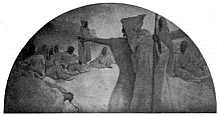
FIG. 1. – TRADITION.
A Mural Decoration in the Library of Congress.
At first thought was recorded and preserved by tradition. An account of a nation's deeds, its laws, the precepts of its religion were stamped, printed, on the memory of persons specially trained to memorize these things and hand them down by word of mouth from generation to generation (Fig. 1). These persons were usually priests, who underwent long years of daily and hourly training in memorizing what was to be handed down. The Sanskrit Vedas, the sacred scripture of the Hindoos, were for many centuries transmitted by tradition, and it is said it took forty years to memorize them. It is a wonder it did not take longer, for the Vedas make a volume as large as our Bible. It is believed that primitive people everywhere first adopted the method of tradition to record and preserve the thought which they did not wish to perish. We may say, then, that the first book was written on the tablet of the human memory.
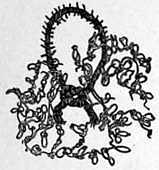
FIG. 2. – THE QUIPU OF THE PERUVIANS.
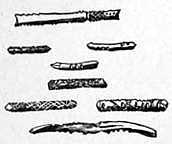
FIG. 3. – MESSAGE-STICKS.
The first step in the growth of the book was taken when memory aids were invented. Sometimes we tie a knot in a handkerchief to help us to remember something. Now, it was just by tying knots that primitive man first lent assistance to the memory. The first material book was doubtless a series of knots well represented by the quipu (Fig. 2) of the ancient Peruvians. This curious-looking book was written (tied) by one known as the officer of the knots. It contains an account of the strength of the Peruvian army, although it is confessed that its exact meaning cannot be made out. It was not intended to be read by any one who was not a keeper of the knots. Books made of knots were used by nearly all the ancient peoples of South America and by some of those of Asia. Akin to the knotted cord is the notched stick, which is still used in Australia by the savages to assist the memory of one who has a message to carry. Figure 3 shows a variety of such message-sticks. The lowest one – a crooked branch of a tree – contains an invitation to a dancing party. The notches are read by the messenger. The notched stick as an aid to memory is not confined to savage races. Many a highly civilized baker has kept his accounts by making notches in sticks and so has many a modern dairyman, as he has delivered milk from door to door.
Memory aids were followed by picture-writing. To express thought by means of pictures is an instinct shared alike by the lowest savage and the most enlightened people. All over the earth we find examples of early picture-writing. A beloved chief had died, a fierce battle had been fought, an exciting chase had occurred: promptly the event was pictured on a stone or on the skin of some animal. Pages might be filled with illustrations of these primitive picture-books, but we must be content with a single specimen (Fig. 4). This was found painted on a rock in California: "We selected this as a camping place, but we have found nothing," say the human figures f, g, h, i. The upturned palms say plainly, "nothing, nothing." "One of our comrades (d) has died of starvation," say the three lank figures at c pointing to their own lean bodies. "We deeply mourn his loss," says the sorrow-stricken a. "We have gone northward," says j, his distinguished arm extended to the north.
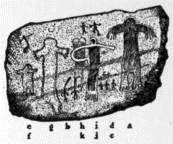
FIG. 4. – PICTURE WRITING.
Practice in picture-making was bound to lead to shorter methods of expressing ideas. It was soon found that reduced pictures, or picture-signs, would suffice to express ideas. Thus, if the idea of sorrow was to be expressed it was not necessary to draw an elaborate picture of a sorrowful looking man like a in Figure 4; a weeping eye would express the idea just as well. Instead of numerous figures (e, f, g, h, i) weeping and saying, "nothing here," a single pair of empty palms would say the same thing just as clearly. In this way a pair of clasped hands came to mean "friendship"; two trees meant "a forest"; a calf running toward water meant "thirst." These picture-signs, of course, assumed the form in which they could be most easily and rapidly drawn. The weeping eye became




Picture-signs (ideographs) followed picture-writing in almost every country where the people were progressive. China was writing its books with picture-signs many thousands of years ago, and it is writing them in the same clumsy way still. Even in highly civilized countries picture-signs have not been entirely abandoned. Examine the advertising page of a newspaper or observe the business signs on the street and you will find picture-signs – pictures that are always made in the same way and that always stand for the same thing.
Each of the great nations of antiquity had its own peculiar system of writing, but the system that should interest us most is that of ancient Egypt, for it is to ancient Egypt that you must look for the origin of the book that is in your hands. The book in Egypt passed through the stages of tradition, memory aids, picture-writing and picture-signs (ideographs); then it passed into the alphabetic stage. Since the alphabet is certainly the most wonderful and perhaps the most useful of all inventions, and since it is an Egyptian invention, it is well worth your while to learn how the Egyptian picture-signs – hieroglyphics they are called – grew into letters, but if you wish to understand the change you will have to give the subject very close attention.
Well, here was the Egyptian system of picture-signs consisting of several thousand pictures of birds, beasts, reptiles, insects, trees, flowers, and objects of almost every description. Now suppose you were employed in writing English by means of several thousand picture-signs and in the course of an hour would have to write the words manage, mansion, mantle, mandate, might it not occur to you that it would be a good thing if that sound man could be represented by the picture-sign for man (


The phonogram led to the alphabet. The scribes in seeking a way to shorten their work found that the syllable itself could be broken up into separate sounds. For example, when they came to the syllable whose sound is spelled by our three letters pad, they found that it had three distinct sounds, namely: (1) one a lip sound which could be represented by the first sound of the picture-sign





